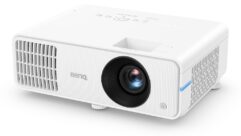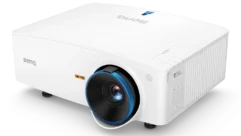
Projector Technologies
Jul 1, 2004 12:00 PM,
By Bennett Liles
This is an exciting time in the world of projection technology. Until recently, there had been a pretty familiar array of players on the commercial scene, each using a distinctly different imaging technique and touting the specific performance advantages provided by that system. CRTs introduced people to big-screen video. As analog devices, they have no fixed number of pixels. That gives them an ability to produce a smooth picture from a great range of input sources with various native resolutions.
These are the units that use three large CRT tubes or “guns” to project a converged image from all three. A problem lies in the fact that the gun convergence needs frequent and fairly laborious tweaking to maintain perfect alignment. Size and power consumption have also been negative factors.
With the arrival of liquid crystal display (LCD) and DLP during the ’90s, many of these big beasts, which resemble sawed-off battleship gun turrets, migrated from the ceiling to the storeroom and finally to oblivion. Some fixed-installation venues, however, still use CRT projectors quite successfully.

One-chip DLP projection.
TRANSMISSIVE VS. REFLECTIVE
First, here is a quick look at the basic structure of projectors. They consist of two main sections: the video decoder and the light engine. The decoder section houses all of the product’s input and compatibility features, and the connector types usually indicate the available input format selections. The light engine is made up of the lamp, the color splitter or color wheel, and the projection optics. The differences among CRT, LCD, DLP, and newer projector technologies center on how the decoded input signal is modulated or mixed with the lamp beam for the throw to the screen. This stage is roughly equivalent to the amplitude and frequency modulation methods of commercial radio transmission. In light engines, the most general mode of performing this image modulation is described either as transmissive or reflective.
CRT can be technically classified as a transmissive technology because it beams light directly through its guns onto the screen. Although the back of the lamp may contain highly reflective material to concentrate the light beam, no reflective elements are used to modulate the image display with the decoded electronic input signal.
Three-chip DLP projection.

LCD
The more prominent transmissive projection technology is LCD, sometimes known as TFT-LCD for its use of thin-film transistors (TFTs). An LCD is a sandwich of glass plate and color filter plate with the liquid crystal between the two. The liquid crystal is able to respond quickly to a changing electronic signal by polarizing to varying degrees the light passing through it. This was the first digital projection scheme used widely, and it excels in its brightness and color reproduction. LCDs exhibit analog display properties through their ability to vary continuously the polarization that the liquid crystal gives the light. Also, they finely control the light transmission on each pixel.
The low per-unit cost of this well-established technology presents an economical choice between light, portable single-panel units with sharper images, and the greater light output and color fidelity offered by three-panel LCD projectors. In these, dichroic mirrors split the light and modulates it separately as red, green, and blue beams. The separate colors are then combined and sent through the lens as one complete image — but some degree of sharpness is lost in the fusion of the color beams. The portable one-panel models can weigh as little as two pounds. LCD models can exhibit contrast ratios as high as 800:1. A major advantage of LCD projectors has been their light efficiency. Transmissive projection tends to produce brighter images using less power from the lamp than do the reflective types.

The fact that their images have to travel through the modulation medium rather than bounce off it, however, introduces a serious limitation. The passage through a medium introduces artifacts into the light beam, and with large LCD displays — those more than 84 inches on the diagonal — pixel patterns become noticeable. This is commonly known as the “chicken wire” or “screen door” effect, and it works to limit the market for LCD projectors for very large displays. However, the low cost, the maturity of the panel technology, and the superior color fidelity have kept LCD technology in mainstream use.
HTPS
One variant of LCD technology, an active-matrix transmissive method with its own set of performance specs, is high-temperature polysilicon (HTPS). HTPS is a microdisplay technology used in TVs and projectors. Such microdisplay devices are commonly known as “panels.” The HTPS name indicates an elevated manufacturing temperature. Most amorphous silicon panels have a processing temperature of 300 to 400 degrees Celsius, and the HTPS panels are produced at around 1,000 degrees Celsius.
This scheme also uses TFTs as light valves. Somewhat higher contrast ratios result from the HTPS displays’ ability to embed driver integrated circuits directly onto the edge surfaces of the TFT. This and other characteristics have made HTPS an LCD method best suited for projectors as opposed to computers, cell phones, and PDAs.
One of those other characteristics is response time. This is the time needed for the light transmission to respond to changes in the encoded driving signal. For static PC data displays, the response time is not that critical. But the burgeoning use of multimedia, particularly video clips, has made response time an increasingly respected parameter in reducing after-image artifacts in motion display.
The components of a digital micromirror device.

HTPS resolution has now reached SXGA+ (1400 by 1050 pixels), and intrapixel spacing has shrunk to 12 microns, pushing up image clarity. Epson, the leader in HTPS development, is promising greater advances in this LCD technology by 2005.
LCOS
Primarily used in rear-screen display products, liquid crystal on silicon (LCOS) is a recently devised projection process that incorporates on the panel a highly reflective substrate that’s covered with the liquid crystal. A separate sublayer contains the miniaturized electronic elements needed to control the activation of each pixel in the image.
Currently, LCOS panels are manufactured in progressive-scan resolutions of 1280 by 768 and 1920 by 1080. A principal advantage in the construction of LCOS chips is that they put the control switching and wiring under the reflecting layer instead of around the edges. This allows a nearly seamless display that eliminates almost all screen door and burn-in effects.
Right now the cost is higher than for other LCD or DLP products, but that price is coming down. By the end of 2005, single-panel LCOS models are expected to match or surpass the performance of older three-panel LCD units — at lower prices.
Although LCOS panels use liquid crystal technology, they may be viewed as a reflective or transmissive modulation method because the upper-layer LCDs either open or block the light reflected from the substrate below. Although they are frequently marketed as something totally new, these components actually combine some of the positive characteristics of older LCD and newer reflective image-modulation schemes.
A chip containing the digital micromirror device.

LCOS projectors are still somewhat expensive and large (about 12 pounds and up), but they excel in their superior resolution. These projectors start at SXGA (1365-by-1024 pixels), and they go much higher. LCOS units’ current prices limit them primarily to the industrial market. The most obvious advantage of LCOS projectors is the outstanding smoothness of the image, with almost no pixelization even at close viewing. As with any three-panel projection system, color reproduction is better than what single-chip LCD products offer using color wheel encoding. The problems of LCOS technology include shorter lamp life than other types and lower contrast ratios than some of the newer reflective types.
D-ILA
A JVC version of LCOS, direct drive image light amplifier modulation (D-ILA) is a reflective liquid crystal device that incorporates the advantages of the older ILA Super Projectors. In the early ’90s, Hughes — JVC Technology Corp. marketed these projectors. These machines featured up to 12,000 lumens with a contrast ratio of over 1000:1.
Responding to a need to reduce the size, complexity, and cost of ILA projectors, JVC introduced the D-ILA, which directly projects picture signals onto pixels. This results in imaging panels with high resolution and better temperature stability. In addition, the implementation of the reflective principle allowed a faster response time for better motion display. The easy scalability of D-ILA panels allows them to thrive simultaneously in more compact applications and in higher-resolution devices. D-ILA also boasts a higher pixel density than most other modulation schemes. This bears particular promise in securing D-ILA a prominent place in the area of electronic cinema, with its demands for 4000-by-2000 resolution.

DLP
Digital light processing (DLP) and other modern reflective imaging systems employ micro-electromechanical systems (MEMS) to modulate the image signal onto the projected beam. MEMS are devices that combine CMOS and other electronics processes with micromechanical elements such as actuators, sensors, and, in this case, tilting mirrors on a silicon substrate. This technology promises to bring forth complete systems on a chip. These will allow microelectronic circuits to interact with their surrounding environment through microscopically machined sensing and activation. Essentially, MEMS are microcircuits with eyes and arms.
The most significant MEMS application used in projection technology is a design known as the digital micromirror device (DMD), developed in 1987 by Dr. Larry Hornbeck of Texas Instruments. The DMD reacts to rapid changes in the electronic input signal by altering the shape or angle for tiny sections of a reflective surface. The projector light beam hits this surface, and parts of the beam are reflected through or away from the lens in reaction to changes of the input signal voltages in the substrate circuitry below the reflective layer.
The DMD chip can have from 800 to more than a million tiny mirrors on its surface. Each mirror is 16 millionths of a meter square and can tilt by 10 or -10 degrees from its center position by allowing movement of its physical surfaces within air gap layers that separate them. Reacting to voltages at the address electrodes, each mirror tilts so that its pixel of the projected light beam either is reflected to a light absorber or shines through the projector lens. The length of time that each mirror is “on” or shining through the lens determines the shade of gray of the corresponding pixel in the picture. The longer the “on” time, the lighter the pixel. Each mirror is controlled in this way as a completely separate element independent of all others, producing up to 1,024 different shades of gray.
DMD, often described as DLP, reproduces color in most systems by using a color wheel similar to that used in single-chip LCD projectors. The color wheel spins rapidly and passes all the visible colors through the beam in sequence while the mirrors are controlled to vary brightness pixel by pixel. Integration of the available gray scale with the six-panel color wheel provides the capability to reproduce more than 16 million colors. The color persistence of the human eye reassembles the separate, alternating colors in a way faithful to the original image. Large, three-chip DLP cinema systems can reproduce more than 35 trillion colors. Stunningly sharp images are possible because the mirrors are spaced less than one micron apart. This virtually eliminates pixelization and provides significantly more reflective surface area that’s covered by the picture. The image occupies about 89 percent of the DMD surface, while on typical LCD devices, this figure is from 12 to 50 percent.
Advances are underway with DLP that will likely produce even greater reliability, resolution, and low-priced improvements to color. The new HD2+ design for DMDs by Texas Instruments adds a fourth color — dark green — to the color wheel for up to 3000:1 contrast ratio with better color. Also on the horizon are new mirror coatings and contrast ratio improvement from DMDs with a darker “off” state.
Magnified views of an LCD picture (left) and a DLP image (right).

Sequential color recapture promises to replace the present color wheel with a Spiral of Archimedes RGB color pattern that could rival current three-chip DLP systems by putting all three colors on the DMD at once instead of sequentially. This will also eliminate a problem that afflicts many DLP projectors, called the “rainbow effect.” This shimmering effect is noticeable when a viewer shifts visual attention from one area of the screen rapidly to another. It is only momentary, but it can be very distracting. The new three-chip DLP systems, higher color wheel speeds, and other DLP improvements continue to minimize this effect.
The contrast ratios of DLP systems tend to exceed those of the various LCD devices. That’s because when each DMD is tilted “off,” it transmits less residual light through the lens than do LCD devices in their “off” state. As a reflective projection technology, DLP also generates fewer artifacts than does the passage of light through the modulation medium in transmissive systems. Currently, the most limiting factor in DLP is its comparative cost.
GLV
Two key parameters in the throughput of any light projection system are the pixel count or array size and the modulation rate, sometimes called switching speed. Much has been said about array size and resolution capabilities, but the absolute master of switching speed is the grating light valve (GLV). This makes GLV systems highly desirable in applications requiring high data rates and fine gray-scale values.
The grating light valve is the champion in switching speed.

The GLV, which is designated as a micro-opto-electromechanical structure, consists of a silicon wafer over which is suspended a series of parallel microribbons, forming a tiny air gap between them and the substrate. Each of these conductive ribbons is deflected downward toward the substrate when a small voltage is applied to the ribbon. In the coplanar or “all up” state, the ribbons present a smoothly reflective surface for reflecting light. When alternate ribbons are deflected only a few hundred nanometers downward, the surface of the chip exhibits a nonreflective state and effectively turns its pixel off. There is no physical contact across the air gap, so wear and fatigue are not serious factors. GLV technology has found a home within high-resolution displays and digital imaging systems that use very high data rates and require the appropriate switching speeds. The amount of light reflected from the GLV surface can be varied in an analog manner or instantly turned on or off. At near-zero voltage, the ribbons will naturally assume the “up” state. One of the big advances in GLV systems is that they can use much simpler control circuits than most other projection devices. A static pixel display can be maintained at a near-zero voltage state, minimizing power needs. Some GLV chips can switch their states a million times faster than LCDs.LET THERE BE LIGHTThe various schemes for modulating electronic video signals onto projected light beams have started to converge. They’ve migrated from a state in which several very different technologies exhibited their own characteristic strong points in specific applications to a plateau where the best points of previously divergent methods have been combined. These new and emerging image panels promise to push resolution, brightness, and data speed capabilities to new highs — while sending costs in the other direction.Bennett Lilesis a freelance television production engineer and audiovisual technician in the Atlanta area. He specializes in government video production, distance learning, and videoconferencing.Key Parameters in Projection TechnologyResolutionThis determines the clarity and sharpness of the projected image. Higher resolution usually costs more. This specification is expressed either as the total number of pixels or as a ratio of the number of pixels across the screen horizontally and the number of pixels vertically.BrightnessThis parameter is measured in ANSI lumens, and as one might expect, more is better — and more expensive.Contrast RatioThis is the comparison between the brightest and the darkest areas of the projected image. High contrast ratio means a sharper appearance, but high ambient light reduces this specification. Venues with a lot of ambient light require very high-contrast-ratio projection products — above 800:1.
- 1000 lumens: the least expensive projectors on the market. These require a dark or dimly lit room.
- 2000 lumens: suitable for most conference rooms and classrooms. Most will need a room in which the lighting near the screen can be reduced.
- 3000 lumens: the most expensive portable business projectors are in this group. Models in this group can accommodate large conference rooms and small auditoriums.
- Above 3000 lumens: These are large projectors generally used in big auditoriums, churches, and concert venues.










